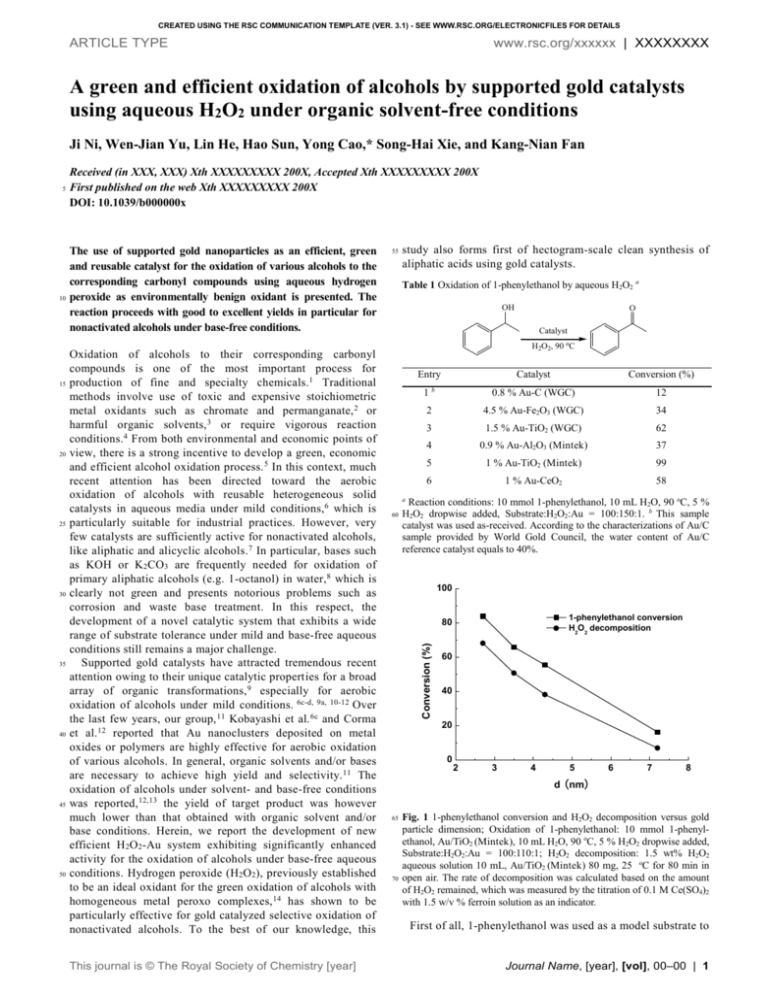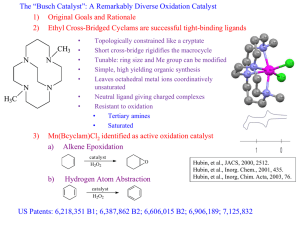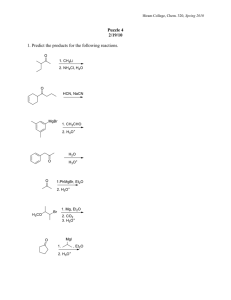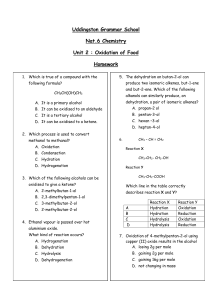RSC Communication Template (Version 3.1)
advertisement

CREATED USING THE RSC COMMUNICATION TEMPLATE (VER. 3.1) - SEE WWW.RSC.ORG/ELECTRONICFILES FOR DETAILS ARTICLE TYPE www.rsc.org/xxxxxx | XXXXXXXX A green and efficient oxidation of alcohols by supported gold catalysts using aqueous H2O2 under organic solvent-free conditions Ji Ni, Wen-Jian Yu, Lin He, Hao Sun, Yong Cao,* Song-Hai Xie, and Kang-Nian Fan 10 15 20 25 30 35 40 45 50 Received (in XXX, XXX) Xth XXXXXXXXX 200X, Accepted Xth XXXXXXXXX 200X First published on the web Xth XXXXXXXXX 200X DOI: 10.1039/b000000x The use of supported gold nanoparticles as an efficient, green and reusable catalyst for the oxidation of various alcohols to the corresponding carbonyl compounds using aqueous hydrogen peroxide as environmentally benign oxidant is presented. The reaction proceeds with good to excellent yields in particular for nonactivated alcohols under base-free conditions. Oxidation of alcohols to their corresponding carbonyl compounds is one of the most important process for production of fine and specialty chemicals.1 Traditional methods involve use of toxic and expensive stoichiometric metal oxidants such as chromate and permanganate, 2 or harmful organic solvents, 3 or require vigorous reaction conditions. 4 From both environmental and economic points of view, there is a strong incentive to develop a green, economic and efficient alcohol oxidation process. 5 In this context, much recent attention has been directed toward the aerobic oxidation of alcohols with reusable heterogeneous solid catalysts in aqueous media under mild conditions,6 which is particularly suitable for industrial practices. However, very few catalysts are sufficiently active for nonactivated alcohols, like aliphatic and alicyclic alcohols.7 In particular, bases such as KOH or K2CO3 are frequently needed for oxidation of primary aliphatic alcohols (e.g. 1-octanol) in water, 8 which is clearly not green and presents notorious problems such as corrosion and waste base treatment. In this respect, the development of a novel catalytic system that exhibits a wide range of substrate tolerance under mild and base-free aqueous conditions still remains a major challenge. Supported gold catalysts have attracted tremendous recent attention owing to their unique catalytic properties for a broad array of organic transformations, 9 especially for aerobic oxidation of alcohols under mild conditions. 6c-d, 9a, 10-12 Over the last few years, our group, 11 Kobayashi et al. 6c and Corma et al. 12 reported that Au nanoclusters deposited on metal oxides or polymers are highly effective for aerobic oxidation of various alcohols. In general, organic solvents and/or bases are necessary to achieve high yield and selectivity. 11 The oxidation of alcohols under solvent- and base-free conditions was reported, 12,13 the yield of target product was however much lower than that obtained with organic solvent and/or base conditions. Herein, we report the development of new efficient H 2O2-Au system exhibiting significantly enhanced activity for the oxidation of alcohols under base-free aqueous conditions. Hydrogen peroxide (H2O2), previously established to be an ideal oxidant for the green oxidation of alcohols with homogeneous metal peroxo complexes, 14 has shown to be particularly effective for gold catalyzed selective oxidation of nonactivated alcohols. To the best of our knowledge, this This journal is © The Royal Society of Chemistry [year] 55 study also forms first of hectogram-scale clean synthesis of aliphatic acids using gold catalysts. Table 1 Oxidation of 1-phenylethanol by aqueous H2O2 a OH O Catalyst H2O2, 90 oC Entry Catalyst Conversion (%) 1b 0.8 % Au-C (WGC) 12 2 4.5 % Au-Fe2O3 (WGC) 34 3 1.5 % Au-TiO2 (WGC) 62 4 0.9 % Au-Al2O3 (Mintek) 37 5 1 % Au-TiO2 (Mintek) 99 6 1 % Au-CeO2 58 a 60 Reaction conditions: 10 mmol 1-phenylethanol, 10 mL H2O, 90 oC, 5 % H2O2 dropwise added, Substrate:H2O2:Au = 100:150:1. b This sample catalyst was used as-received. According to the characterizations of Au/C sample provided by World Gold Council, the water content of Au/C reference catalyst equals to 40%. 100 1-phenylethanol conversion H2O2 decomposition 80 Conversion (%) 5 60 40 20 0 2 3 4 5 6 7 8 d (nm) 65 70 Fig. 1 1-phenylethanol conversion and H2O2 decomposition versus gold particle dimension; Oxidation of 1-phenylethanol: 10 mmol 1-phenylethanol, Au/TiO2 (Mintek), 10 mL H2O, 90 oC, 5 % H2O2 dropwise added, Substrate:H2O2:Au = 100:110:1; H2O2 decomposition: 1.5 wt% H2O2 aqueous solution 10 mL, Au/TiO2 (Mintek) 80 mg, 25 oC for 80 min in open air. The rate of decomposition was calculated based on the amount of H2O2 remained, which was measured by the titration of 0.1 M Ce(SO4)2 with 1.5 w/v % ferroin solution as an indicator. First of all, 1-phenylethanol was used as a model substrate to Journal Name, [year], [vol], 00–00 | 1 5 10 15 20 25 30 35 study the catalytic activity of the different supported gold catalysts. The results of these studies (Table 1) show that gold supported on carbon leads to very low conversion (ca. 12%). The Au/Fe2O3 and Au/Al 2O3 catalysts show moderate activity (ca. 3437 %), while Au/TiO2 supplied by the World Gold Council and Au/CeO 2 give a higher conversion value (ca. 5862%), gold supported on TiO 2 supplied by Mintek afford the highest conversion (ca. 99%), with yields of isolated product of between 98 and 100%‡. No conversion was found in the absence of catalyst or the use of Au-free TiO2 catalysts under similar reaction conditions. Additional examination of the relationship between the alcohol oxidation activities and a series of Mintek Au/TiO2 catalysts calcined at elevated temperatures (Figs. S1-4 in ESI†) revealed that use of smaller Au nanoparticles gave higher activity as shown in Fig. 1. This result, together with the fact that the small Au NPs can substantially facilitate the crucial H 2O2 decomposition,15 strongly suggests that the high dispersion of Au NPs in combination with a beneficial synergetic interaction with the TiO2 support is the key factor for achieving high activity in the H2O2-mediated oxidation of alcohols. The Mintek Au/TiO2 catalyst was stable and can be easily reused in the oxidation of 1-phenylethanol. After the first alcohol oxidation, the catalyst was separated from the reaction mixture by filtration, thoroughly washed with water, and then reused as catalyst for the next run under the same conditions. As shown in Fig. 2, the acetophenone yields remained essentially constant for the five successive cycles, reflecting high stability and reusability of the catalyst. This was consistent with the characterization results for this catalyst. TEM and XPS results (Figs. S5 and S7 in ESI†) showed essentially no changes in the mean diameters of the Au nanoparticles and in the metallic state of Au, respectively, after the five successive runs. Moreover, it was confirmed by induced coupled plasma techniques (ICP) that the Au content of the used Au/TiO2 catalyst was the same as that of the fresh catalyst and that no Au was in the filtrate. 45 50 55 60 Table 2 Oxidation of non-activated alcohols by aqueous H2O2 a Entry OH OH 1 2 3 4 4b Yield (%) 40 Fig. 2 Recycling of the Mintek Au-TiO2 catalyst for the oxidation of 1phenylethanol: 10 mmol substrate, 10 mL H2O, 90 oC, 5 % H2O2 dropwise added. Substrate:H2O2:Au = 100:150:1. For comparison, the corresponding H2O2 decomposition rates are also included. To examine the scope of the alcohol reaction with the H2O2-Au/TiO2 system, we extended our studies to various 2 | Journal Name, [year], [vol], 00–00 100 98 100 >99 100 >99 100 >99 >99 >99 90 c O OH 5b 6b 65 OH O OH OH O OH OH a Reaction conditions: 10 mmol Substrate, 10 mL H2O, 90 oC, 5 % H2O2 dropwise added, Substrate:H2O2:Au = 100:150:1.b Substrate:H2O2:Au = 100:250:1. c Octyl octanate was found as by-product. Furthermore, it was found that the H2O2-mediated oxidations also proceeded smoothly in a hectogram-scale synthesis to give a high yield formation of corresponding carboxylic acid. As shown in Scheme 1, by stirring a mixture of 1-hexanol (100 g) in the presence of 0.01 molar amount of Au catalyst and 3.0 molar amount of aqueous H 2O2 (5%) for 2.5 h, 1-hexanoic acid could be obtained in a 93 % yield (105.6 g). Notably, this is the first example of hectogramscale clean oxidation of alcohols under base-free conditions in neat water using heterogeneous gold catalysts. OH 5 Number of cycle 87 O 75 0 Sel. (%) O 3 60 0 Conv. (%) O 2 70 20 Product OH 80 40 Substrate 1 alcohol oxidatoin H2O2 decomposition 100 structurally different alcohols. The results are summarized in Table 2. It was found that primary and secondary alcohols were oxidized to the corresponding carboxylic acids and ketones, respectively. Notably, H2O2-Au/TiO2 was capable of catalyzing the oxidation of various nonactivated alcohols. For alicyclic alcohols and secondary aliphatic alcohols, i.e. 2octanol, they gave ketones in excellent yields of 87–98 % (Table 2, entries 1–2). Moreover, it was found that the chemoselective oxidation of allylic alcohols having a terminal double bond, like 1-hexene-3-ol also proceeded efficiently (Table 2, entry 3). Contrastingly, previously reported H2O2-Pt black system is found to be totally inactive for this substrate, owing to a strong coordination of the C=CH2 group to Pt0 complex. 16 It is especially noteworthy that H2O2-Au/TiO2 was highly active for the oxidation of primary aliphatic alcohols, the most inactive alcohols, in the absence of any bases (Table 2, entries 4–6). For example, the yield of 1-hexanoic acid in 1-hexanol oxidation was as high as 99% at a 100% conversion. 100 g 3 mol amt H2O2 1 wt % Au/TiO2 (0.01 mol Au) O 90 oC, 2.5 h OH 105.6 g 93 % yield after distillation This journal is © The Royal Society of Chemistry [year] Scheme 1 Hectogram-scale oxidation of 1-hexanol. 5 10 15 20 Activated alcohols, such as benzylic alcohols, were also oxidized at 90 o C with H 2O2 in the presence of Au/TiO2 to give the corresponding carbonyl compounds in good to excellent yields (Table 3). Like most of the catalysts reported previously, 6-12 Au/TiO2 efficiently catalyzed the oxidation of secondary aromatic alcohol, such as 1-phenyl propanol (Table 3, entry 1), almost quantitatively to their target products (~ 99% yields). Benzyl alcohol was oxidized to benzoic acid at a 100% conversion, although with a selectivity of only 85% (Table 3, entry 2; the other product was mainly benzaldehyde). Benzyl alcohols with electron-donating groups were also successfully oxidized, in which a shift in selectivity from acids to benzaldehydes was observed (Table 3, entries 35). It is worth noting that chemoselective oxidation of cinnamyl alcohol with the sole formation of cinnamaldehyde could be accomplished (Table 3, entry 6). Interestingly, an epoxidized compound of cinnamyl alcohol was not observed. All these results clearly showed the efficiency of the H2O2Au/TiO 2 system in the oxidation of both activated and nonactivated alcohols in water. Table 3 Oxidation of activated alcohols by aqueous H2O2 40 45 50 55 Acknowledgements a 60 Entry Substrate Product Sel. (%) >99 100 O OH 1 Conv. (%) b reaction. The Au-alcoholate complex may be further attacked by H2O2 or the Au-hydridoperoxide complex generated from the reaction of Au 0 with H 2O2, to form the final carbonyl compound via a -elimination pathway. The overall effect is that a dramatically boosted activity for alcohol oxidation is achieved in contrast to the normal aerobic process in which dioxygen or air was used as the oxidant. In summary, we have demonstrated that the Au/TiO2 catalyst has great potential for the environmentally benign oxidation of alcohols with aqueous hydrogen peroxide under mild and organic solvent-free conditions. The H2O2-Au/TiO2 protocol has been proven to be particularly efficient in the oxidative transformation of nonactivated alcohols in aqueous media. The stability of the catalyst has also been demonstrated convincingly by conducting five successive runs without significant drop in the reaction rate. Further extension of the present H 2O2-Au catalytic system to many other key oxidative transformations is currently being explored. Financial support by the National Natural Science Foundation of China (20633030, 20721063 and 20873026), the National Basic Research Program of China (2003CB 615807), Shanghai Education Committee (06SG03) and Science & Technology Commission of Shanghai Municipality (08DZ2270500, 07QH14003) is kindly acknowledged. Notes and references O OH 2 OH >99 85 c >99 44 c >99 61 c 65 O OH 3 O OH 70 O O OH 4 OH 5 2 OH >99 37.5 c 3 Cl 6b 1 75 O OH Department of Chemistry & Shanghai Key Laboratory of Molecular Catalysis and Innovative Material, Fudan University, Shanghai 200433, P. R. China. Fax: (+86-21) 65642978; Tel: (+86-21) 55665287; E-mail: yongcao@fudan.edu.cn † Electronic Supplementary Information (ESI) available: Experimental section, TEM and XPS data. See DOI: 10.1039/b000000x/ ‡ Without the use of H2O2 (under an air atmosphere), acetophenone was obtained in only < 10% yield over the Mintek Au-TiO2 catalyst. Cl OH O >99 100 a 25 30 35 Reaction conditions: 10 mmol Substrate, 10 ml H2O, 90 oC, 5 % H2O2 dropwise added, Substrate:H2O2:Au = 100:250:1. b Substrate:H2O2:Au = 100:150:1. c Aldehyde was found as by-product. 80 Attempting to gain insight into the origin of the enhanced activity achieved by using aqueous H 2O2 as oxidant is important. Although extensive mechanistic study has not yet been conducted, it is known that the -hydrogen abstraction of an alcohol may be involved in the rate determining step based on the isotope kinetic study (kH/kD = 1.7-2.0).17 In addition, H2O2 was found to be indispensable for the reaction progress as inferred by the data in Fig. 1, which prompted us to propose a possible mechanism of the present H2O2-Aumediated alcohol oxidation as illustrated in Fig. S8 (ESI†). The key aspect of H 2O2 is to facilitate the abstraction of the hydrogen as a hydrogen scavenger, leading to the formation of a meta-alcoholate species during the initial step of the This journal is © The Royal Society of Chemistry [year] 4 85 5 6 90 95 7 8 100 R. A. Sheldon, J. K. Kochi, Metal-Catalyzed Oxidation of Organic Compounds, Academic Press, New York, 1981. W. J. Mijs, C. R. H. de Jonge, Organic Synthesis by Oxidation with Metal Compounds, Plenum Press, New York, 1986. (a) Z. Hou, N. Theyssen, A. Brinkmann, W. Leitner, Angew. Chem. Int. Ed., 2005, 44, 1346; (b) B. Z. Zhan, M. A. White, T. K. Sham, J. A. Pincock, R. J. Doucet, K. V. R. Rao, K. N. Robertson, T. S. Cameron, J. Am. Chem. Soc., 2003, 125, 2195; (c) B. T. Guan, D. Xing, G. X. Cai, X. B. Wan, N. Yu, Z. Fang, Z. J. Shi, J. Am. Chem. Soc., 2005, 127, 18004. (a) C. X. Zhang, P. Chen, J. Liu, Y. H. Zhang, W. Shen, H. L. Xu, Y. Tang, Chem. Commun., 2008, 3290; (b) J. Shen, W. Shan, Y. H. Zhang, J. M. Du, H. L. Xu, K. N. Fan, W. Shen, Y. Tang, Chem. Commun., 2004, 2880. T. Mallat, A. Baiker, Chem. Rev., 2004, 104, 3037. (a) Y. Uozumi, R. Nakao, Angew. Chem. Int. Ed., 2003, 42, 194; (b) Y. M. A. Yamada, T. Arakawa, H. Hocke, Y. Uozumi, Angew. Chem, Int. Ed., 2007, 46, 704; (c) H. Tsunoyama, H. Sakurai, Y. Negishi, T. Tsukuda, J. Am. Chem. Soc., 2005, 127, 9374; (d) H. Miyamura, R. Matsubara, Y. Miyazaki, S. Kobayashi, Angew. Chem. Int. Ed., 2007, 46, 4151; (e) K. Mori, T. Hara, T. Mizugaki, K. Ebitani, K. Kaneda, J. Am. Chem. Soc., 2004, 126, 10657. T. Wang, C. X. Xiao, L. Yan, L. Xu, J. Luo, H. Shou, Y. Kou, H. C. Liu, Chem. Commun., 2007, 4375. (a) X. Wang, H. Kawanami, N. M. Islam, M. Chattergee, T. Yokoyama, Y. Ikushima, Chem. Commun., 2008, 4442; (b) H. Tsunoyama, T. Tsukuda, H. Sakurai, Chem. Lett., 2007, 36, 212; (c) G. ten Brink, I. W. C. E. Arends and R. A. Sheldon, Science, 2000, Journal Name, [year], [vol], 00–00 | 3 9 5 10 10 15 20 11 25 12 13 30 14 35 40 15 16 45 17 287, 1636; (d) B. P. Buffin, J. P. Clarkson, N. L. Belitz, A. Kundu, J. Mol. Catal. A: Chem., 2005, 225, 111. (a) L. Prati, M. Rossi, J. Catal., 1998, 176, 552; (b) A. Corma, P. Serna, Science, 2006, 313, 332; (c) C. H. Christensen, B. Jorgensen, J. RassHansen, K. Egeblad, R. Madsen, S. K. Klitgaard, S. M. Hansen, M. R. Hansen, H. C. Andersen, A. Riisager, Angew. Chem. Int. Ed., 2006, 45, 4648; (d) F. Z. Su, L. He, J. Ni, Y. Cao, H. Y. He, K. N. Fan, Chem. Commun., 2008, 3531; (e) J. E. Bailie, G. J. Hutchings, Chem. Commun., 1999, 2151; (f) T. Hayashi, K. Tanaka, M. Haruta, J. Catal., 1998, 178, 566; (g) A. K. Sinha, S. Seelan, S. Tsubota, M. Haruta, Angew. Chem. Int. Ed., 2004, 43, 1546. (a) S. Carrettin, P. McMorn, P. Johnston, K. Griffin, G. J. Hutchings, Chem. Commun., 2002, 696; (b) N. F. Zheng, G. D. Stucky, Chem. Commun., 2007, 3862; (c) P. Haider, A. Baiker, J. Catal., 2007, 248 175; (d) C. Burato, P. Centomo, G. Pace, M. Favaro, L. Prati, B. Corain, J. Mol. Catal. A, 2005, 238, 26; (e) D. I. Enache, J. K. Edwards, P. Landon, B. Solsona-Espriu, A. F. Carley, A. A. Herzing, M. Watanabe, C. J. Kiely, D. W. Knight, G. J. Hutchings, Science, 2006, 311, 362. (a) F. Z. Su, Y. M. Liu, L. C. Wang, Y. Cao, H. Y. He, K. N. Fan, Angew. Chem. Int. Ed., 2008, 47, 334; (b) L. C. Wang, L. He, Q. Liu, Y. M. Liu, M. Chen, Y. Cao, H. Y. He, K. N. Fan, Appl. Catal. A: Gen., 2008, 344, 150; (c) L. C. Wang, Y. M. Liu, M. Chen, Y. Cao, H. Y. He, K. N. Fan, J. Phys. Chem. C, 2008, 112, 6981. (a) A Abad, P. Concepcion, A. Corma, H. García, Angew. Chem. Int. Ed., 2005, 44, 4066; (b) A. Abad, C. Almela, A. Corma and H García, Tetrahedron, 2006, 62, 6666. D. I. Enache, D. W. Knight, and G. J. Hutchings, Catal. Lett., 2005, 103, 43. (a) B. M. Trost, Y. Masuyama, Tetrahedron Lett., 1984, 25, 173; (b) O. Bortolini, V. Conte, F. Di Furia, G. Modena, J. Org. Chem., 1986, 51, 2661; (c) G. Barak, J. Dakka, Y. Sasson, J. Org. Chem., 1988, 53, 3553; (d) Y. Ishii, K. Yamawaki, T. Ura, H. Yamada, T. Yoshida, M. Ogawa, J. Org. Chem., 1988, 35, 35873; (e) R. Zennaro, F. Pinna, G. Strukul, H. Arzoumanian, J. Mol. Catal., 1991, 70, 269; (f) C. Venturello, M.Gambaro, J. Org. Chem., 1991, 56, 5924; (g) A. C. Dengel, W. P. Griffith, B. C. Parkon, J. Chem. Soc. Dalton Trans., 1993, 2683; (h) R. Neumann, M. Gara, J. Am. Chem. Soc., 1995, 117, 5066. The higher H2O2 decomposition rate achieved for catalysts with smaller Au particle size can be attributed to the higher abundance of low-coordinated Au atoms, which are also believed to be the key sites for low temperature CO oxidation. (a) Y. Kon, Y. Usui, K. Sato, Chem. Commun., 2007, 4399; (b) Y. Kon, H. Yazawa, Y. Usui, K. Sato, Chem. Asian J., 2008, 3, 1642. A. Abad, A. Coma, H. García, Chem. Eur. J., 2008, 14, 2. 4 | Journal Name, [year], [vol], 00–00 This journal is © The Royal Society of Chemistry [year]







